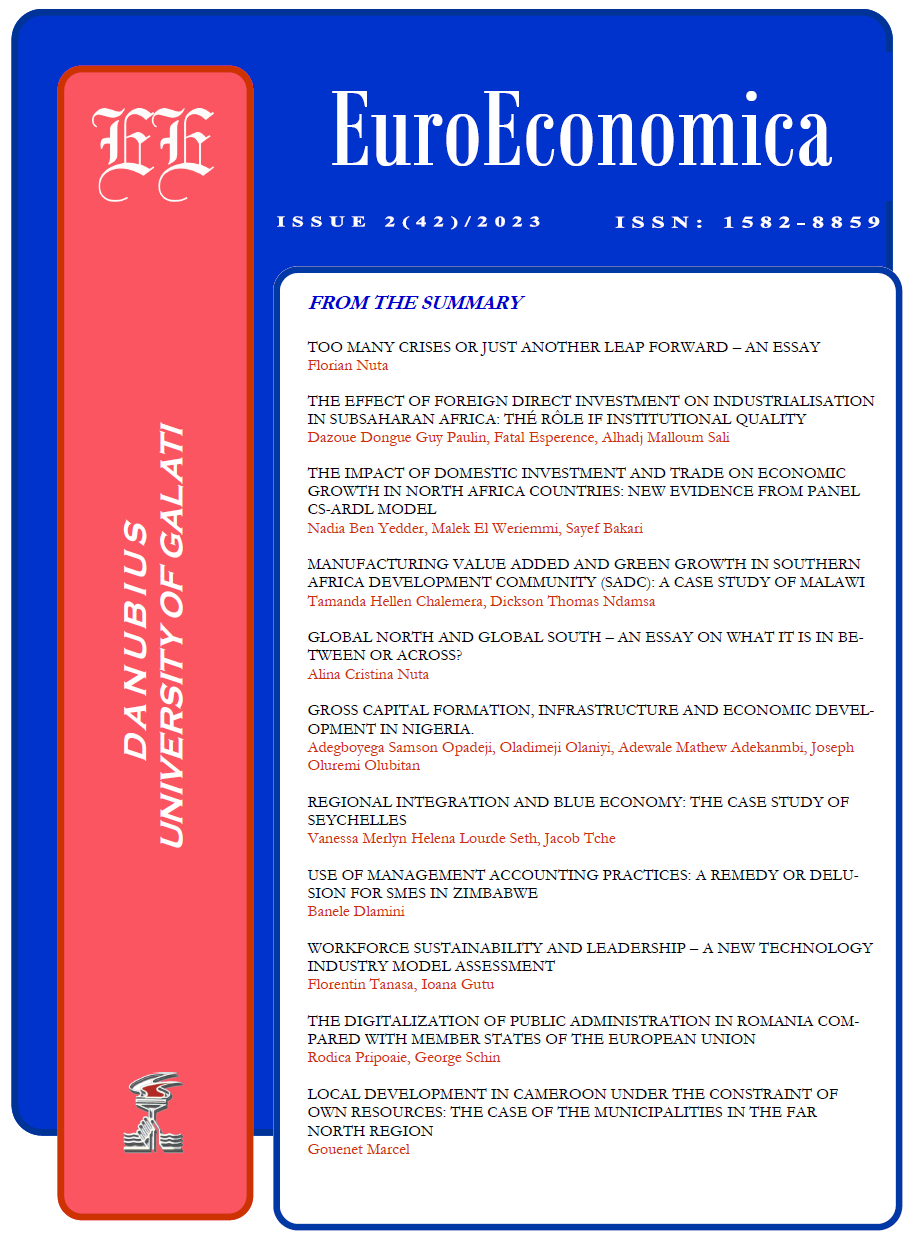Manufacturing Value Added and Green Growth in Southern Africa Development Community (Sadc): A Case Study of Malawi
Keywords:
Manufacturing value-added; green growth; ARDLAbstract
The relationship between manufacturing value-added and green growth is crucial as the manufacturing sector has the potential to drive economic growth but can also have significant environmental consequences. This way, this paper aims to examine the effects of manufacturing value-added on green growth in Malawi. The analysis employs the Autoregressive Distributed Lag (ARDL) model to examine the short and long-term relationship between manufacturing value added and green growth. The ARDL model is estimated using time series data from 1990 to 2019. The results indicate a positive and significant relationship between manufacturing value added and green growth, rejecting the pollution haven hypothesis. This implies that increased manufacturing value added leads to increased green growth. The study also finds that total greenhouse gas emissions impact green growth negatively and significantly. These findings highlight the need to foster green growth by promoting manufacturing value-added activities, encouraging sustainable manufacturing practices, and strengthening environmental regulations and standards.
References
*** (2013). United Nations Industrial Development Organization (UNIDO). Retrieved from https://stat.unido.org.
Chen, L.; Li, X. & Wang, L. (2021). The effects of manufacturing value added on green growth: Evidence from dynamic panel data approach. Environmental Science and Pollution Research, 28(7), pp. 9267-9280.
Cole, M.A.; Elliot, R.J. & Shimamoto, K. (2005) industrial pollution in Japan: the role of regulatory policies and community factors. Journal of Development Economics, 77(1), pp. 247–267.
Crichton, S.; Huq, S. & Aslam, A. (2018). Mainstreaming climate change in national planning and development in Malawi. Springer International Publishing.
Gujarati, D. & Porter, D. (2009). Basic Econometrics (5th ed.). New York: McGraw Hill.
Hogendorn, C. (2012). The pollution haven hypothesis: An economic evaluation of the theory, pp. 17-34. Springer.
Jayet, C.; Chazot, G.; Dumas, B. & Melka, A. (2018). Decarbonising Southern Africa’s energy sector. IDDRI, 23.
Kaldor, N. (1966). Causes of the slow rate of economic growth of the United Kingdom. Cambridge University Press.
Lazonick, W. (2014). Sustainable prosperity in the new economy? Business organisation and high-tech employment in the United States. Journal of Economic Behaviour and Organization, p. 103, S39-S59.
Mhango, C. & Zikhali, P. (2017). Manufacturing value added on environmental sustainability in Malawi. Journal of sustainable development, 12(3), pp. 135–152.
Nguyen, G.; Rizwan, M. & Isik, C. (2021). Manufacturing value added and green growth: evidence from ASEAN countries. Environmental Science and Pollution Research, 28(8), pp. 9548-9564.
OECD. (2012). OECD-WTO statistics on value added in gross exports: Bibliographic note (No. 1333). OECD Publishing.
OECD. (2017). Green Growth Indicators 2017. Retrieved from https://www.oecd.org/greengrowth/Green -Growth-Indicators-2017.pdf.
Pesaran, H. & Shin, Y. (1999). An Autoregressive Distributed Lag Modelling Approach to Cointegration Analysis. Econometrics and Economic Theory in the 20th Century: The Ragnar Frisch Centennial Symposium. Cambridge University Press.
Pesaran, H., Shin, Y. & Smith, R. (2001). Bounds Testing Approaches to the Analysis of Level Relationships. Journal of Applied Econometrics, 16.
Porter, M.E. (1991). America’s Green Strategy. Scientific American, 264(4), pp. 168-173.
Sandhiya, G. & Nataraj, G. (2020). Manufacturing value added and environmental sustainability nexus in India: Evidence from Panel data analysis—Journal of cleaner production, 256, p. 120340.
Southern Africa Development Community (SADC). (2015). SADC regional renewable energy and energy efficiency strategy and action plan. Retrieved from https://www.sadc.int/files/3814/3809/4429/SADC-SRT-Approve.pdf.
Southern African Development Community (SADC). (2014). SADC green growth framework. Retrieved from https://www.sadc.int/files/9713/1776/8262/SADC_Green_Growth_Framework.pdf.
Southern African Development Community (SADC). (2019). SADC regional climate change strategy. Retrieved from https://www.sadc.int/files/4415/3967/0703/Region_Climate _change_strategy.pdf.
Talukdar, S.; Nolte, I. & Thoma, G. (2020). The environmental effects of manufacturing value added: panel data evidence from 82 countries: ecological economics, 169, p. 106503.
Tang, C.; & Dou, J. (2021). The Impact of Heterogeneous Environmental Regulations on Location Choices of Pollution-Intensive Firms in China. Frontiers in Environmental Science. doi doi.org/10.3389/fenvs.2021.79944.
World Bank (2021). Malawi. Retrieved from https://data.worldbank.org/country/malawi.
Downloads
Published
How to Cite
Issue
Section
License
Copyright (c) 2023 Tamanda Hellen Chalemera, Dickson Thomas Ndamsa

This work is licensed under a Creative Commons Attribution-NonCommercial 4.0 International License.
The author fully assumes the content originality and the holograph signature makes him responsible in case of trial.


